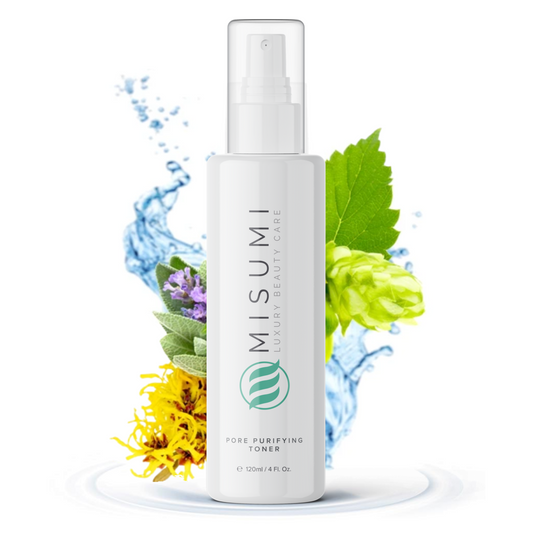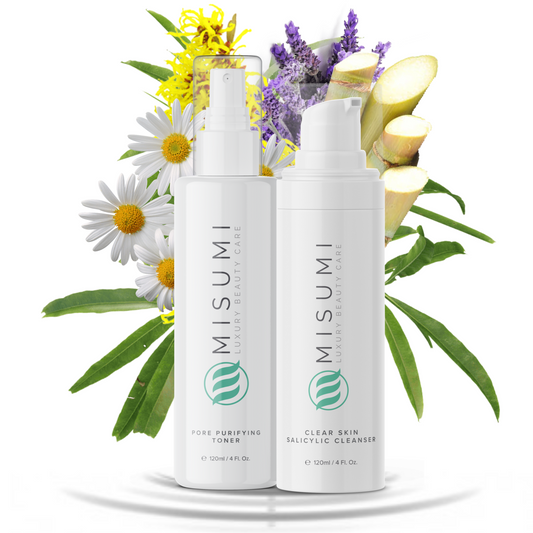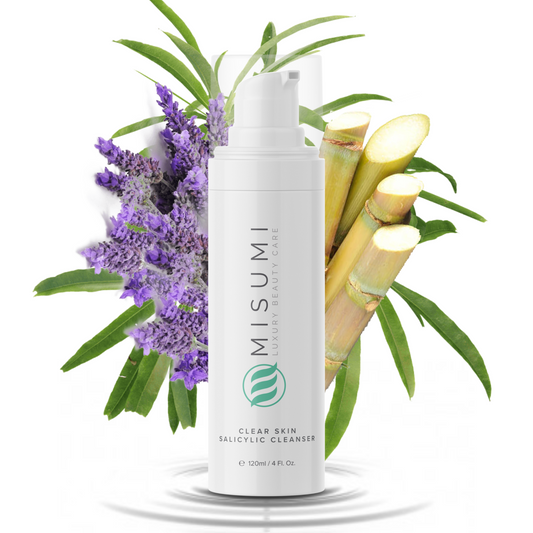Acids are widely used in many skin treatments, ranging from masks to peels. Every acid has a different function when applied and benefits the skin in different ways.
There are already existing acids on your skin, but by incorporating acid treatments into your beauty regimen, you increase their quantity, which increases their benefits.
Hyaluronic acid and glycolic acid are two of the most commonly used types. But which is better for improving the skin and giving you a brighter complexion?
What is Hyaluronic Acid and Where Can It Be Found?

Also known as "hyaluronan," this popular acid already exists in our bodies. Our eyes and joints contain the highest concentration of hyaluronic acid. Aging and environmental factors, among other things, play a critical role in the amount of hyaluronic acid our body retains, so we naturally lose some of it as we age.
The human body contains around 15 grams of hyaluronan, a third of which is synthesized daily.
It can be derived from many sources, especially in food. It can also be found in supplement and powder form, and people usually take it for osteoarthritis and other joint problems. You can also use it topically, and there are many different hyaluronic acid serums and other products on the market.
The Functions of Hyaluronic Acid
Although it has many functions, its main objective is to keep the skin hydrated and moisturized, which it does by retaining the water in our bodies. This is why it’s a perfect option for people with dry skin. It enhances the moisture content on the skin, so if you suffer from dry skin or dry patches, invest in a skincare product that contains hyaluronic acid or pick up a straight hyaluronic acid serum. When applied topically, it hydrates the pores and prevents dullness.
In addition, hyaluronic acid lubricates the joints and other connective tissues, providing a protective coat in the cells of the articular cartilage.
It’s also the main acid used for lip fillers.

Sounds pretty amazing, right? Well, there's even more. Below are some of the benefits you can experience from this miracle acid if you decide to incorporate it into your routine.
The Benefits of Using Hyaluronic Acid
An Incredible Moisturizer
As we’ve mentioned before, hyaluronic acid plays a crucial role in maintaining the skin’s natural moisture and softness.
If you want to experience its hydrating benefits, purchase products like creams and moisturizers that already contain hyaluronic acid. Since it’s such a common skincare ingredient, you might also be using it without even realizing it. Check the ingredient list of your favorite cosmetic products before going out and buying a new one. It will probably appear as "sodium hyaluronate."
If you're using a hyaluronic acid moisturizer, it's really easy to incorporate it into your routine. Wash your face with your normal cleanser, follow it up with a toner to help with acne (like this one right here), and apply the moisturizer at the end.
As a result of using this acid regularly, your skin will be dewy and glowing.
Hyaluronic Acid as a Wound Healer

Wounds are tricky to deal with, and we all get them from time to time. You might be wondering how a hydrating acid could possibly work on wound healing. Well, it decreases the inflammation in the body while the wound is healing. Also, due to its antibacterial properties, it reduces the risk of infection during the process of healing.
Hyaluronic Acid as an Anti-Aging Treatment
The natural levels of hyaluronic acid decrease as we grow older. But don’t despair! You can slow this process down by incorporating cosmetic products that contain hyaluronic acid in your skincare routine or taking oral supplements.
It works by drastically increasing the moisture in our skin, which reduces the appearance of wrinkles. It’s believed that people with dry skin tend to get premature signs of aging, like wrinkles and fine lines, quicker than those with normal or oily skin. Therefore, not only does hyaluronic acid work on existing wrinkles and lines, but it can also prevent them from occurring in the first place.
That’s why it’s one of the main ingredients used in fillers. The acid will give the skin a youthful appearance.
What is Glycolic Acid Where Can It Be Found?

This type of acid has become quite the trend in the beauty and skincare community.
Glycolic acid is an alpha hydroxy acid (AHA), a group known as "fruit acids." As the name suggests, it’s mainly found in fruit and is usually derived from sugar cane. It’s one of the safest AHAs for the skin - including sensitive skin types.
Like hyaluronic acid, glycolic acid also naturally occurs in the body. It performs many functions, so let’s see what those are.
The Functions of Glycolic Acid
Glycolic acid has similar functions to hyaluronic acid. Both glycolic acid and hyaluronic acid make your skin soft. Glycolic acid breaks down and loosens the substances on the skin barrier. It provides natural exfoliation, which is why it's effective for shedding off dead skin cells and revealing smoother skin underneath.
Glycolic acid also moisturizes the skin inside out, which is why it’s a great option for dry skin types. In addition, glycolic acid stimulates the growth of new cells, collagen, and elastin, which improves your overall complexion, leaving you with flawless and hydrated skin all year round.
Because it has anti-aging and exfoliating properties and can reach the lower skin layers, glycolic acid is also an amazing option for people who want youthful-looking skin without wrinkles and fine lines.
Due to these anti-aging and replenishing properties, it’s the main ingredient in many chemical peels. Other than that, it’s commonly used in many cosmetic and skincare products, such as creams, gels, and toners that treat scarring, hyperpigmentation, and even acne.
The Benefits of Using Glycolic Acid
Glycolic Acid for Acne-Prone Skin
You’ve probably heard by now that the build-up of dead skin cells combined with excess sebum and acne-causing bacteria is the main reason why you might end up with acne.
Since the main function of glycolic acid is getting rid of dead skin cells, it can be useful for treating acne. Not only that, but it also prevents future acne breakouts by renewing the skin frequently. What’s not to love?
Studies show that glycolic acid has a positive effect on acne, particularly glycolic acid peel therapy.
The Anti-Aging Benefits of Glycolic Acid
Similarly to hyaluronic acid, the levels of naturally occurring glycolic acid in the skin decrease as we age. But don’t worry; there’s hope! Using products containing glycolic acid will improve your skin health, making it more radiant, youthful, and smooth in no time.
Because of its moisturizing benefits, it will prevent wrinkles and fine lines from occurring in the first place, and it will minimize the appearance of existing ones.
But that’s not all! As mentioned, glycolic acid also stimulates collagen production, one of the most important ingredients for preserving that youthful look.
#1 Recommended Glycolic Acid Cleanser
We recommend trying Misumi's AHA 10% Skin Perfecting Cleanser. Developed to fight blemishes and blackheads while reducing age spots and wrinkles, this Skin Perfecting Cleanser is a breakthrough product in the acne-fighting and anti-aging industry. Naturally derived, it's proven to help clear acne and increase elasticity, achieving firmer and younger-looking skin.
Possible Side Effects

Even though the name sounds intimidating, hyaluronic acid doesn’t have many side effects and is generally safe to use. Our bodies produce it naturally, so there are very few reported allergic reactions to it.
The same goes for glycolic acid. It’s marked as generally safe and pretty harmless when used properly.
It’s important to note that pregnant women and women who are breastfeeding should be wary about taking oral supplements.
In addition, hyaluronic acid is marked as unsafe for people suffering or recovering from cancer because it can potentially make the cells grow faster.
Using glycolic acid can result in a tingling sensation on the skin. If you experience this, it’s nothing to worry about. But if the sensation increases and it starts to burn, you should stop using it immediately.
Things to Keep in Mind
Your skin will need time to adjust to these acids. So, unless you’re already using products that contain both acids, it’s best to incorporate them slowly into your skincare routine.
Be careful when using glycolic acid if you’re on isotretinoin (Accutane.) Consult your doctor if you want to introduce any glycolic acid product to your routine. Just like Accutane, they can make your skin more sensitive to sun exposure, so don’t forget to wear sunscreen regularly and limit your exposure to the sun.
If you notice any negative effects, such as dryness, irritation, and redness, contact your dermatologist immediately and stop using the products.
The Verdict

Both acids are extremely beneficial when dealing with dry, flakey, dull skin. They both have great anti-aging properties, making them an incredible option for mature skin types.
However, glycolic acid is a better option for those who want to treat acne or those looking for an effective skin exfoliator. Unlike hyaluronic acid, glycolic acid will eliminate all those dead skin cells.
If you suffer from extremely dry skin or patches and are looking for a great moisturizer, go for one that contains hyaluronic acid. Make sure to do a patch test first.
Both hyaluronic acid and glycolic acid are easy to incorporate into your skincare routine, and almost every brand has some variation of products that contain them. So you should definitely give them a try at some point.
References
Glycolic acid peel therapy – a current review
Hyaluronic acid: A key molecule in skin aging














